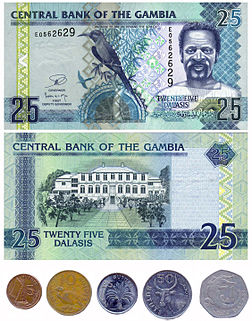
Back Dalasi Afrikaans دالاسي غامبي Arabic دالاسى جامبى ARZ Dalasi AST Гамбійскі даласі Byelorussian Даласі BE-X-OLD Гамбийско даласи Bulgarian গাম্বিয়ান ডালাসি BPY Dalasi Breton Dalasi Catalan
 25 dalasi note and coins from 5 bututs to 1 dalasi | |
| ISO 4217 | |
|---|---|
| Code | GMD (numeric: 270) |
| Subunit | 0.01 |
| Unit | |
| Plural | dalasis or dalasi |
| Symbol | D |
| Denominations | |
| Superunit | |
| 5 | pound |
| Subunit | |
| 1⁄100 | butut |
| Plural | |
| butut | bututs |
| Banknotes | 5, 10, 20, 25, 50, 100, 200 dalasis |
| Coins | 1, 5, 10, 25, 50 bututs, 1 dalasi |
| Demographics | |
| Date of introduction | 1971 |
| Replaced | Gambian pound |
| User(s) | |
| Issuance | |
| Central bank | Central Bank of The Gambia |
| Website | www |
| Valuation | |
| Inflation | 7.1% |
| Source | The World Factbook, 2019 est. |
The dalasi is the currency of The Gambia that was adopted in 1971. It is subdivided into 100 bututs. It replaced the Gambian pound at a rate of 1 pound = 5 dalasis, i.e. 1 dalasi = 0.2 pound = 4 shillings.
The derivative of dala is unknown. In numerous languages in the Francophonie, currency terms (including batut, dalasi, doromi, teemer) refer to the former 5 French West African franc note (the lowest denomination at the time), but to which the origins are not known. One speculated origin is a pronunciation of "dollar"; however, variants of dalasi in other Mandinka dialects (such as daasi) counter this speculation[1] while butut is from Wolof butuut, "small thing".[2]
As a result of inflation, now bututs coins have completely disappeared from circulation and the minimum monetary unit has become 50 Butut.[citation needed]
- ^ "Definition of DALASI". www.merriam-webster.com.
- ^ "Definition of BUTUT". www.merriam-webster.com.